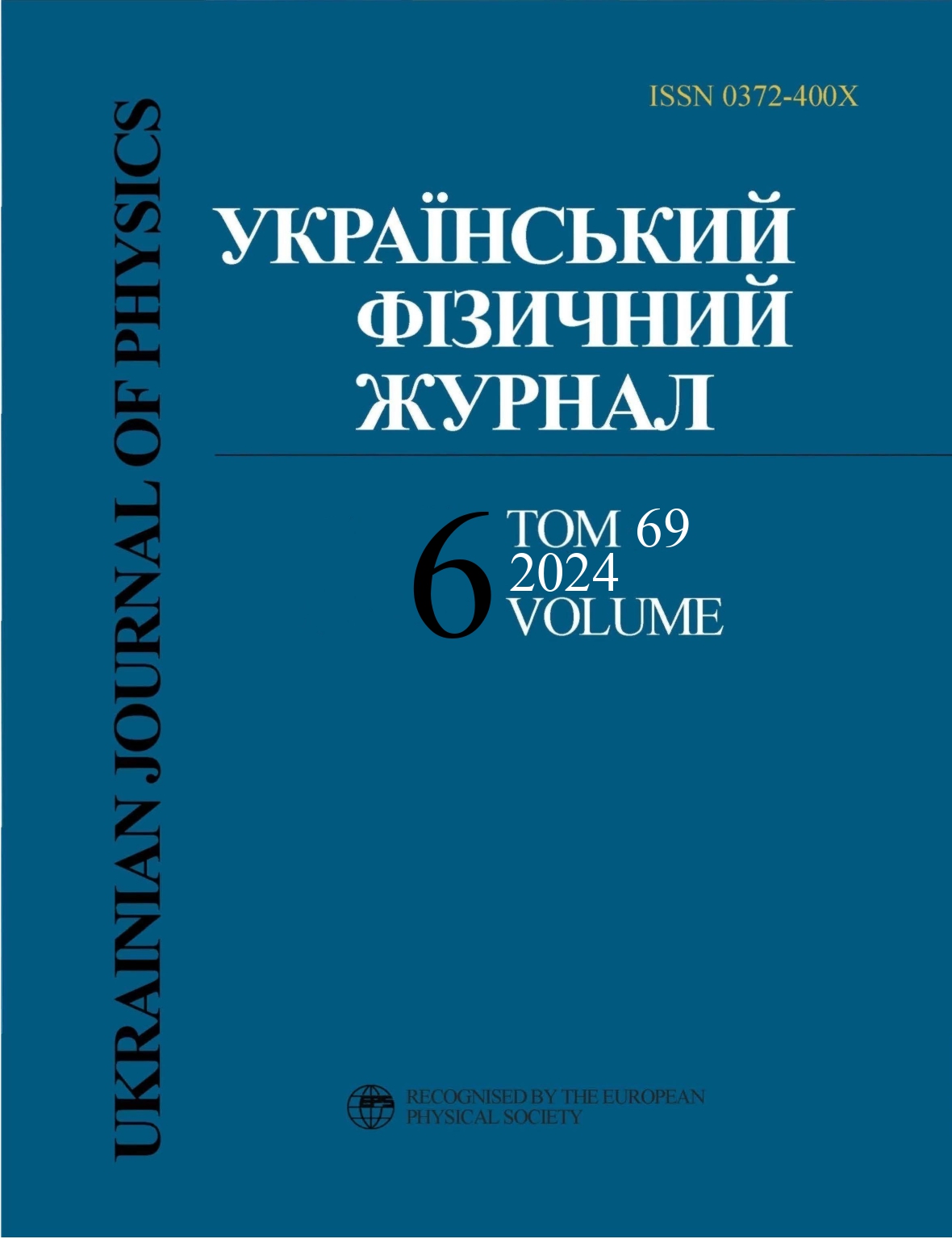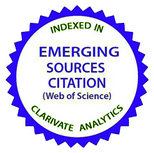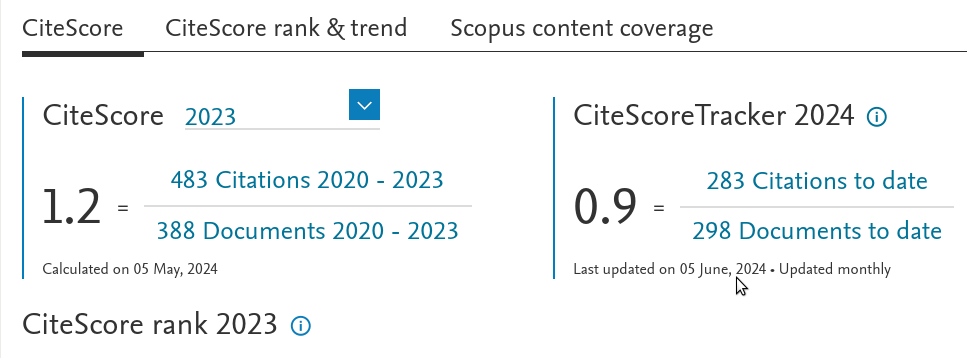Електрокерування поверхневими плазмонними коливаннями в гомеотропній комірці нематичного рідкого кристала
DOI:
https://doi.org/10.15407/ujpe69.6.417Ключові слова:
нематичний рiдкий кристал, орiєнтацiйна нестiйкiсть, гiстерезис орiєнтацiйного переходу, переднахил директора, енергiя зчеплення, поверхневий плазмонний поляритонАнотація
Теоретично вивчається iндукована електричним полем орiєнтацiйна нестiйкiсть директора в комiрцi гомеотропно орiєнтованого нематичного рiдкого кристала (НРК) за наявностi переднахилу директора на поверхнi пiдкладинки. Встановлено, що орiєнтацiйнi переходи поля директора НРК з вихiдного однорiдного стану в суттєво неоднорiдний з наступним переходом в планарний стан, зумовленi змiною величини напруженостi електричного поля, можуть супроводжуватися гiстерезисами. За наявностi останнiх розраховано значення їх параметрiв i встановлено областi їх iснування в залежностi вiд величин параметрiв НРК-комiрки. Встановлено, що збiльшення переднахилу директора на поверхнi та зростання енергiї зчеплення НРК з похилою легкою вiссю приводять до звуження ширини петлi гiстерезису, а в подальшому i до зникнення гiстерезису зазначених орiєнтацiйних переходiв. Дослiджено поширення плазмонного поляритона на поверхнi комiрки НРК у випадку обмеженостi однiєї з її полiмерних пiдкладинок з iншого боку шаром золота. Розраховано величину ефективного показника заломлення поверхневого плазмонного поляритона (ППП) та встановлено, що вона зменшується зi збiльшенням напруженостi електричного поля. Встановлено, що дiапазон керування величиною ефективного показника заломлення ППП розширюється зi зменшенням значень кута орiєнтування похилої легкої осi та товщини полiмерного шару, а також зi збiльшенням довжини хвилi ППП та оптичної анiзотропiї НРК.
Посилання
I.-C. Khoo. Liquid Crystals (John Wiley and Sons, 2022) [ISBN: 978-1-119-70582-6].
T. Kato, J. Uchida, T. Ichikawa, T. Sakamoto. Functional liquid crystals towards the next generation of materials. Angew. Chem. Int. Edit. 57, 4355 (2018).
https://doi.org/10.1002/anie.201711163
S. Sato. Applications of liquid crystals to variable-focusing lenses. Opt. Rev. 6, 471 (1999).
https://doi.org/10.1007/s10043-999-0471-z
M. Schadt. Liquid crystal materials and liquid crystal displays. Annu. Rev. Mater. Sci. 27, 305 (1997).
https://doi.org/10.1146/annurev.matsci.27.1.305
P.-G. De Gennes, J. Prost. The Physics Of Liquid Crystals (Oxford University Press, 1993) [ISBN: 9780198517856].
https://doi.org/10.1093/oso/9780198520245.001.0001
J. P. Lagerwall, G. Scalia. A new era for liquid crystal research: Applications of liquid crystals in soft matter nano-, bio-, and microtechnology. Curr. Appl. Phys. 12, 1387 (2012).
https://doi.org/10.1016/j.cap.2012.03.019
J. A. Castellano. Surface anchoring of liquid crystal molecules on various substrates. Mol. Cryst. Liq. Cryst. 94, 33 (1983).
https://doi.org/10.1080/00268948308084245
I. Yakovkin, A. Lesiuk, M. Ledney, V. Reshetnyak. Director orientational instability in a planar flexoelectric nematic cell with easy axis gliding. J. Mol. Liq. 363, 119888 (2022).
https://doi.org/10.1016/j.molliq.2022.119888
O. Tarnavskyy, M. Ledney. Orientational instability of the director in a nematic cell caused by electro-induced anchoring modification. Condens. Matter Phys. 24, 13601 (2021).
https://doi.org/10.5488/CMP.24.13601
A. Ellison, I. A. Cornejo. Glass substrates for liquid crystal displays. Int. J. Appl. Glass Sci. 1, 87 (2010).
https://doi.org/10.1111/j.2041-1294.2010.00009.x
O. Tarnavskyy, A. Savchenko, M. Ledney. Two-dimensional director configurations in a nematic-filled cylindrical capillary with the hybrid director alignment on its surface. Liq. Cryst. 47, 851 (2020).
https://doi.org/10.1080/02678292.2019.1685688
O. Tarnavskyy, M. Ledney. Equilibrium locations of defects in two-dimensional configurations of the nlc director field. Liq. Cryst. 50, 21 (2023).
https://doi.org/10.1080/02678292.2022.2161017
A. Lesiuk, M. Ledney, O. Tarnavskyy. Orientational instability of nematic liquid crystal in a homeotropic cell with boundary conditions controlled by an electric field. Liq. Cryst. 46, 469 (2019).
https://doi.org/10.1080/02678292.2018.1508769
A. Lesiuk, M. Ledney, O. Tarnavskyy. Orientational instability induced by the electric field in a cell of a nematic liquid crystal with negative dielectric anisotropy. Ukr. J. Phys. 62, 779 (2017).
https://doi.org/10.15407/ujpe62.09.0779
B.Y. Zel'dovich, N. Tabiryan, Y. S. Chilingaryan. Freedericksz transitions induced by light fields. Sov. Phys. JETP 54, 32 (1981).
S. Durbin, S. Arakelian, Y. Shen. Optical-field-induced birefringence and freedericksz transition in a nematic liquid crystal. Phys. Rev. Lett. 47, 1411 (1981).
https://doi.org/10.1103/PhysRevLett.47.1411
A. Zolot'ko, V. Kitaeva, N. Kroo, N. Sobolev, L. Chillag. The effect of an optical field on the nematic phase of the liquid crystal ocbp. JETP Lett. 32, 158 (1980).
https://doi.org/10.1007/978-94-011-3180-3_10
E. Brasselet, A. Lherbier, L.J. Dub'e. Transverse nonlocal effects in optical reorientation of nematic liquid crystals. J. Opt. Soc. Am. B 23, 36 (2006).
https://doi.org/10.1364/JOSAB.23.000036
M. Ledney, I. Pinkevych. Influence of anchoring at a nematic cell surface on threshold spatially periodic reorientation of a director. Liq. Cryst. 34, 577 (2007).
https://doi.org/10.1080/02678290500248160
A. Lesiuk, M. Ledney, O. Tarnavskyy et al. Electro-optical effect in a planar nematic cell with electric field sensitive boundary conditions. Mol. Cryst. Liq. Cryst. 647, 320 (2017).
https://doi.org/10.1080/15421406.2017.1289623
U. A. Laudyn, A. E. Miroshnichenko, W. Krolikowski et al. Observation of light-induced reorientational effects in periodic structures with planar nematic-liquid-crystal defects. Appl. Phys. Lett. 92, 203304 (2008).
https://doi.org/10.1063/1.2936085
A.E. Miroshnichenko, E. Brasselet, Y.S. Kivshar. Lightinduced orientational effects in periodic photonic structures with pure and dye doped nematic liquid crystal defects. Phys. Rev. A 78, 053823 (2008).
https://doi.org/10.1103/PhysRevA.78.053823
M. Ledney, O. Tarnavskyy, A. Lesiuk, V.Y. Reshetnyak. Interaction of electromagnetic waves in nematic waveguide. Mol. Cryst. Liq. Cryst. 638, 1 (2016).
https://doi.org/10.1080/15421406.2016.1217700
G. Barbero, N. Madhusudana, G. Durand. Weak anchoring energy and pretilt of a nematic liquid crystal. J. Phys. Lett.-Paris 45, 613 (1984).
https://doi.org/10.1051/jphyslet:019840045012061300
K.-W. Lee, A. Lien, J.H.S. Paek. Control and modification of nematic liquid crystal pretilt angles on polyimides. Jpn. J. Appl. Phys. 36, 3591 (1997).
https://doi.org/10.1143/JJAP.36.3591
B. Cerrolaza, M.A. Geday, J. Oton, X. Quintana, N. Bennis. Measuring thickness and pretilt in reflective vertically aligned nematic liquid crystal displays. Mol. Cryst. Liq. Cryst. 494, 222 (2008).
https://doi.org/10.1080/15421400802430331
D. Seo, H. Matsuda, T. Oh-Ide, S. Kobayashi. Alignment of nematic liquid crystal (5cb) on the treated substrates: Characterization of orientation films, generation of pretilt angles, and surface anchoring strength. Mol. Cryst. Liq. Cryst. A 224, 13 (1993).
https://doi.org/10.1080/10587259308032475
F. K. Lee, B. Zhang, P. Sheng, H.S. Kwok, O.K. Tsui. Continuous liquid crystal pretilt control through textured substrates. Appl. Phys. Lett. 85, 5556 (2004).
https://doi.org/10.1063/1.1833552
W.-T. Wu. Liquid Crystal Pretilt Angle Control. Mechanism, Electro-Optical Properties and Numerical Analysis. Ph.D. thesis (2016) [ISBN: 9789402804348].
L. Weng, P.-C. Liao, C.-C. Lin et al. Anchoring energy enhancement and pretilt angle control of liquid crystal alignment on polymerized surfaces. AIP Adv. 5, 097218 (2015).
https://doi.org/10.1063/1.4932153
X. Nie, R. Lu, H. Xianyu, T.X. Wu, S.-T. Wu. Anchoring energy and cell gap effects on liquid crystal response time. J. Appl. Phys. 101, 103110 (2007).
https://doi.org/10.1063/1.2734870
X. Nie, H. Xianyu, R. Lu, T.X. Wu, S.-T. Wu. Pretilt angle effects on liquid crystal response time. J. Displ. Technol. 3, 280 (2007).
https://doi.org/10.1109/JDT.2007.900926
H.L. Ong. Optically induced Freedericksz transition and bistability in a nematic liquid crystal. Phys. Rev. A 28, 2393 (1983).
https://doi.org/10.1103/PhysRevA.28.2393
A. Vella, B. Piccirillo, E. Santamato. Coupled-mode approach to the nonlinear dynamics induced by an elliptically polarized laser field in liquid crystals at normal incidence. Phys. Rev. E 65, 031706 (2002).
https://doi.org/10.1103/PhysRevE.65.031706
E. Brasselet, B. Piccirillo, E. Santamato. Three-dimensional model for light-induced chaotic rotations in liquid crystals under spin and orbital angular momentum transfer processes. Phys. Rev. E 78, 031703 (2008).
https://doi.org/10.1103/PhysRevE.78.031703
I. Budagovsky, D. Pavlov, S. Shvetsov et al. First-order light-induced orientation transition in nematic liquid crystal in the presence of low-frequency electric field. Appl. Phys. Lett. 101, 021112-1 (2012).
https://doi.org/10.1063/1.4736409
G. D'Alessandro, A. A. Wheeler. Bistability of liquid crystal microcavities. Phys. Rev. A 67, 023816 (2003).
https://doi.org/10.1103/PhysRevA.67.023816
V. Ilyina, S. Cox, T. Sluckin. A computational approach to the optical freedericksz transition. Opt. Commun. 260, 474 (2006).
https://doi.org/10.1016/j.optcom.2005.11.028
M. F. Ledney, O S. Tarnavskyy. Influence of the anchoring energy on hysteresis at the freedericksz transition in confined light beams in a nematic cell. Liq. Cryst. 39, 1482 (2012).
https://doi.org/10.1080/02678292.2012.721902
M. Ledney, O. Tarnavskyy, V. Khimich. Influence of dc electric field on the hysteresis of light-induced Freedericksz transition in a nematic cell. Ukr. J. Phys. 61, 117 (2016).
https://doi.org/10.15407/ujpe61.02.0117
B. Frisken, P. Palffy-Muhoray. Electric-field-induced twist and bend freedericksz transitions in nematic liquid crystals. Phys. Rev. A 39, 1513 (1989).
https://doi.org/10.1103/PhysRevA.39.1513
I.W. Stewart, The Static And Dynamic Continuum Theory Of Liquid Crystals: A Mathematical Introduction, (CRC Press, 2019).
https://doi.org/10.1201/9781315272580
H. Zhou, E.P. Choate, H. Wang. Optical fredericks transition in a nematic liquid crystal layer. In Liquid Crystalline Polymers: Volume 2-Processing and Applications (Springer, 2015), p. 265.
https://doi.org/10.1007/978-3-319-20270-9_11
G. Sprokel, R. Santo, J. Swalen. Determination of the surface tilt angle by attenuated total reflection. Mol. Cryst. Liq. Cryst. 68, 29 (1981).
https://doi.org/10.1080/00268948108073550
G. Sprokel. The reflectivity of a liquid crystal cell in a surface plasmon experiment. Mol. Cryst. Liq. Cryst. 68, 39 (1981).
https://doi.org/10.1080/00268948108073551
K. Welford, J. Sambles. Detection of surface director reorientation in a nematic liquid crystal. Appl. Phys. lett. 50, 871 (1987).
https://doi.org/10.1063/1.98017
K. Welford, J. Sambles, M. Clark. Guided modes and surface plasmon-polaritons observed with a nematic liquid crystal using attenuated total reflection. Liq. Cryst. 2, 91 (1987).
https://doi.org/10.1080/02678298708086641
A. Lesiuk, M. Ledney, V.Y. Reshetnyak. Light-induced fredericks transition in the nematic liquid crystal cell with plasmonic nanoparticles at a cell bounding substrate. Phys. Rev. E 106, 024706 (2022).
https://doi.org/10.1103/PhysRevE.106.024706
K.R. Daly. Light-Matter Interaction In Liquid Crystal Cells. Ph.D. thesis (University of Southampton, 2011).
K.R. Daly, S. Abbott, G. D'Alessandro, D.C. Smith, M. Kaczmarek. Theory of hybrid photorefractive plasmonic liquid crystal cells. J. Opt. Soc. Am. B 28, 1874 (2011).
https://doi.org/10.1364/JOSAB.28.001874
S. B. Abbott. Energy Transfer Between Surface Plasmon Polariton Modes With Hybrid Photorefractive Liquid Crystal Cells. Ph.D. thesis (University of Southampton, 2012).
https://doi.org/10.1364/OL.37.002436
S. B. Abbott, K. R. Daly, G. D'Alessandro, M. Kaczmarek, D. C. Smith. Photorefractive control of surface plasmon polaritons in a hybrid liquid crystal cell. Opt. Lett. 37, 2436 (2012).
https://doi.org/10.1364/OL.37.002436
M.E. Caldwell, E.M. Yeatman. Surface-plasmon spatial light modulators based on liquid crystal. Appl. Opt. 31, 3880 (1992).
https://doi.org/10.1364/AO.31.003880
U. Bortolozzo, S. Residori, J. Huignard. Beam coupling in photorefractive liquid crystal light valves. J. Phys. D 41, 224007 (2008).
https://doi.org/10.1088/0022-3727/41/22/224007
F. Yang, J. Sambles. Microwave liquid crystal wavelength selector. Appl. Phys. Lett. 79, 3717 (2001).
https://doi.org/10.1063/1.1419240
Y. Wang. Voltage-induced color-selective absorption with surface plasmons. Appl. Phys. Lett. 67, 2759 (1995).
https://doi.org/10.1063/1.114584
Y. Wang, S.D. Russell, R.L. Shimabukuro. Voltageinduced broad-spectrum reflectivity change with surfaceplasmon waves. J. Appl. Phys. 97, 023708 (2005).
https://doi.org/10.1063/1.1830093
O. Buchnev, A. Dyadyusha, M. Kaczmarek, V. Reshetnyak, Y. Reznikov. Enhanced two-beam coupling in colloids of ferroelectric nanoparticles in liquid crystals. J. Opt. Soc. Am. B 24, 1512 (2007).
https://doi.org/10.1364/JOSAB.24.001512
G. Cook, A. Glushchenko, V. Reshetnyak et al. Nanoparticle doped organic-inorganic hybrid photorefractives. Opt. Expr. 16, 4015 (2008).
https://doi.org/10.1364/OE.16.004015
W. Dickson, G.A. Wurtz, P.R. Evans, R.J. Pollard, A.V. Zayats. Electronically controlled surface plasmon dispersion and optical transmission through metallic hole arrays using liquid crystal. Nano Lett. 8, 281 (2008).
https://doi.org/10.1021/nl072613g
L. Komitov, G. Barbero, I. Dahl, B. Helgee, N. Olsson. Controllable alignment of nematics by nanostructured polymeric layers. Liq. Cryst. 36, 747 (2009).
https://doi.org/10.1080/02678290902928849
E. Ouskova, Y. Reznikov, S. Shiyanovskii et al. Photoorientation of liquid crystals due to light-induced desorption and adsorption of dye molecules on an aligning surface. Phys. Rev. E 64, 051709 (2001).
https://doi.org/10.1103/PhysRevE.64.051709
A. Rapini, M. Papoular. Distorsion d'une lamelle n'ematique sous champ magn'etique conditions d'ancrage aux parois. J. Phys. Colloq. 30, C4 (1969).
https://doi.org/10.1051/jphyscol:1969413
L.M. Blinov, V.G. Chigrinov. Electrooptic Effects In Liquid Crystal Materials (Springer Science and Business Media, 2012).
Springer Handbook Of Materials Data. Edited by H. Warlimont, W. Martienssen (Springer, 2018).
P.C.-P. Chao, Y.-Y. Kao, C.-J. Hsu. A new negative liquid crystal lens with multiple ring electrodes in unequal widths. IEEE Photon. J. 4, 250 (2012).
https://doi.org/10.1109/JPHOT.2012.2183583
I. Yakovkin, M. Ledney. Electrically induced orientational instability of the director in a homeotropic nematic liquid crystal cell and its effect on surface plasmon oscillations. Phase Transit. 97, 394 (2023).
https://doi.org/10.1080/01411594.2023.2247130
V. Tkachenko, G. Abbate, A. Marino et al. Nematic liquid crystal optical dispersion in the visible-near infrared range. Mol. Cryst. Liq. Cryst. 454, 263 (2006).
Downloads
Опубліковано
Як цитувати
Номер
Розділ
Ліцензія
Ліцензійний Договір
на використання Твору
м. Київ, Україна
Відповідальний автор та співавтори (надалі іменовані як Автор(и)) статті, яку він (вони) подають до Українського фізичного журналу, (надалі іменована як Твір) з одного боку та Інститут теоретичної фізики імені М.М. Боголюбова НАН України в особі директора (надалі – Видавець) з іншого боку уклали даний Договір про таке:
1. Предмет договору.
Автор(и) надає(ють) Видавцю безоплатно невиключні права на використання Твору (наукового, технічного або іншого характеру) на умовах, визначених цим Договором.
2. Способи використання Твору.
2.1. Автор(и) надає(ють) Видавцю право на використання Твору таким чином:
2.1.1. Використовувати Твір шляхом його видання в Українському фізичному журналі (далі – Видання) мовою оригіналу та в перекладі на англійську (погоджений Автором(ами) і Видавцем примірник Твору, прийнятого до друку, є невід’ємною частиною Ліцензійного договору).
2.1.2. Переробляти, адаптувати або іншим чином змінювати Твір за погодженням з Автором(ами).
2.1.3. Перекладати Твір у випадку, коли Твір викладений іншою мовою, ніж мова, якою передбачена публікація у Виданні.
2.2. Якщо Автор(и) виявить(лять) бажання використовувати Твір в інший спосіб, як то публікувати перекладену версію Твору (окрім випадку, зазначеного в п. 2.1.3 цього Договору); розміщувати повністю або частково в мережі Інтернет; публікувати Твір в інших, у тому числі іноземних, виданнях; включати Твір як складову частину інших збірників, антологій, енциклопедій тощо, то Автор(и) мають отримати на це письмовий дозвіл від Видавця.
3. Територія використання.
Автор(и) надає(ють) Видавцю право на використання Твору способами, зазначеними у п.п. 2.1.1–2.1.3 цього Договору, на території України, а також право на розповсюдження Твору як невід’ємної складової частини Видання на території України та інших країн шляхом передплати, продажу та безоплатної передачі третій стороні.
4. Строк, на який надаються права.
4.1. Договір є чинним з дати підписання та діє протягом усього часу функціонування Видання.
5. Застереження.
5.1. Автор(и) заявляє(ють), що:
– він/вона є автором (співавтором) Твору;
– авторські права на даний Твір не передані іншій стороні;
– даний Твір не був раніше опублікований і не буде опублікований у будь-якому іншому виданні до публікації його Видавцем (див. також п. 2.2);
– Автор(и) не порушив(ли) права інтелектуальної власності інших осіб. Якщо у Творі наведені матеріали інших осіб за виключенням випадків цитування в обсязі, виправданому науковим, інформаційним або критичним характером Твору, використання таких матеріалів здійснене Автором(ами) з дотриманням норм міжнародного законодавства і законодавства України.
6. Реквізити і підписи сторін.
Видавець: Інститут теоретичної фізики імені М.М. Боголюбова НАН України.
Адреса: м. Київ, вул. Метрологічна 14-б.
Автор: Електронний підпис від імені та за погодження всіх співавторів.

















